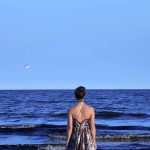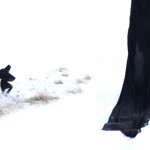Unable to attend the opening of the Museum School MFA Thesis Exhibition at Tufts University Art Gallery, I saw the show on a rainy evening last week. Alone save for a few other visitors, I was relieved to find that each of the artists included, Case Hathaway-Zepeda, Paul Ishii, Ryan Kish, Liza Lynch, Vanessa Michalak, John Neylan, D.M.H. R.I.C.H.M.O.N.D. X, were each allotted ample, separate exhibition space. Each of the theses on view here are autonomous and comprehensive bodies of work. Each are fully articulated expressions of an idea or conceit.
Immediately inside the gallery is D.M.H. R.I.C.H.M.O.N.D.'s installation. Ryan Kish's quiet, meditative paintings are installed in the next space. Kish's painting take his native New Hampshire as a subject, and court abstraction and figuration, oscillating between AbEx bravura and exacting, detailed brushwork. Kish's works are complemented by the compulsivity of Liza Lynch's Asunder, a series of paintings in which she meticulously and painstakingly marks small squares in small, delicate strokes of black and white paint, recalling Chuck Close's pixilated portraiture. Her work is bracketed by two large-scale and ambitious installations that smartly expound on the theme of obsession present in Lynch's paintings. Paul Ishii has seamlessly recreated a doctor's waiting room, complete with self-help brochures that confront the premises and promises of such commonplace psychological materials; his simple and open installation pleasantly contrasts with John Neylan's End of the Confusion, which is an enormous plywood box sealed on all sides with a red straw poking out of one and notes on various psychological treatises on another. On the far end of the gallery are Vanessa Michalak's The Great Escape, a series of fantastically colored landscape paintings that articulate nature in a distinctively abstract and emotive vocabulary.
Truly differentiated and tucked into a dark, solitary and quiet room is Case Hathaway-Zepeda's six short video works confronting the process and nuances of grief with graceful painterliness. Each of these videos transforms natural elements--sand, wind, water, trees--in to raw, hyper-realistic representations of the pain and longing of personal loss. In Burial of Metis, we see a woman standing at the shore of a wide, blue ocean. We can't see her feet, but presumably her toes are just at the water's edge, and with her hands to her sides. Her breathing only evident through the slight movement of her shoulders, her dress billows, her hair blowing, but still she remains. Though her face isn't visible as our vantage is behind her, the woman gazes outwards to the infinite horizon, witness to another rotation around the sun. The waves beat the beach, shaping it, just as her experience shapes her. There's a tension between her stillness and the continual cycles of waves, which are just barely audible. Burial of Metis vividly recalls Caspar David Friedrich's Wanderer Above the Sea of Fog, and traces of Romanticism are present in each of Hathaway-Zepeda's six works. As Burial of Metis concludes, two panels are activated to the right of the space, displaying the elegiacal Indelible, in which a man and woman appear, eyes closed and underwater, divided by a narrow strip of black between the panels. The figures move closer to each other, but still never touch, a separation emphasized by their refusal to meet the viewer's gaze. Bubbles flow up from their closed mouths, moving upwards and heightening the painterly, atmospheric affect that Hathaway-Zepeda achieves in each of her videos. Each of these are individual images, accumulating into one of disassociation, separation, longing, and how these emotional phenomenons relate to natural cycles.
Hathaway-Zepeda's works are remote, yet universal. And while each of the artists included here are showing fully-formed works, her's are distinguished through their smart investigation of an integral aspect of humanity: loss.
- Case Hathaway-Zepeda, Limb, 2013, Video, 7:34 min. Courtesy of Case Hathaway-Zepeda and the School of the Museum of Fine Arts.
- Case Hathaway-Zepeda, Burial of Metis, 2012, video, 3:31 min. Courtesy of Case Hathaway-Zepeda and the School of the Museum of Fine Arts.
- Case Hathaway-Zepeda, Indelible, 2012, video, 2:59 min. Courtesy of Case Hathaway-Zepeda and the School of the Museum of Fine Arts.
- Case Hathaway-Zepeda, Stand, 2012, video, 4:12 min. Courtesy of Case Hathaway-Zepeda and the School of the Museum of Fine Arts.
- Case Hathaway-Zepeda, LB in Memory (Part I)2013, video 3:27 min. and LB in Memory (Part II) 2013, video. Courtesy of Case Hathaway-Zepeda and the School of the Museum of Fine Arts.









